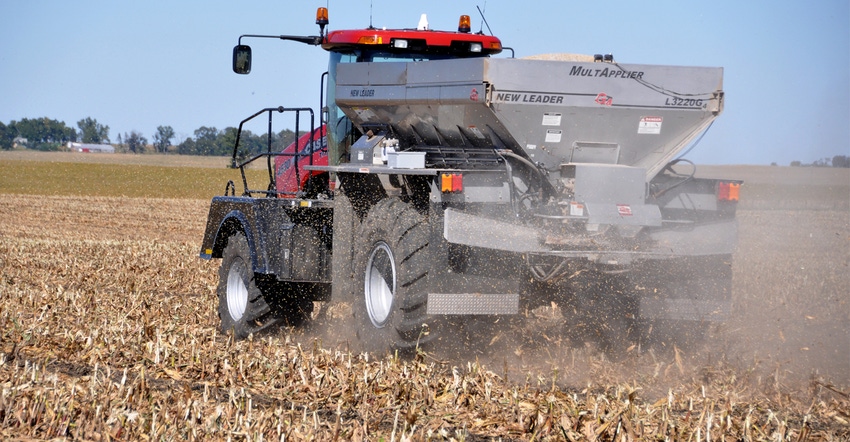September 20, 2018

If someone asked you to describe the 2018 growing season in a few words, what comes to mind? For a lot of us across the state words like “unpredictable,” “erratic” or “frustrating” might make the list.
Similar things might be said about yields. In regions where moisture was the driving issue — too much, not enough or, in some cases, both extremes — yields are down in general, but variability is still a common theme. Other areas had a fairly solid growing season, resulting in respectable yields for the most part.
Field visits and early reports show a high level of variability in some of those fields, too. Storm damage hit some areas hard this year, leading to wild yield swings within and between fields. One of the largest stretches of green snap in recent memory illustrated this variability well before harvest, unfortunately.
Stands in these wind-damaged fields ranged from perfect to complete crop loss, sometimes within the same field. We have variability every year, but dealing with the wider yield swings we see in many places in 2018 can complicate things.
Time to apply fertilizer?
Fall fertilizer season is around the corner, and crop nutrition gives us a lot to think about. So far, we already know yields are all over the place, and commodity markets are ugly. What are fertilizer prices doing now and what could they do? With all this to deal with, how do we approach soil sampling, fertilizer rates and budgets?
It doesn’t seem that long ago, but almost exactly 10 years ago the fertilizer market created a lot of heartburn. Phosphorus and potassium prices were hard to track as they were changing so quickly, but ballpark averages had P around $1,000 to $1,200 and K from $800 to $1,000 a ton.
Yet just five years prior, P was around $300 and K just over $200. I don’t know of any industry experts or global trends that would point to prices going that far up or down in the next few years; rather, it illustrates how volatile fertilizer markets can be.
It also gives a little better context to the phrase “P and K prices are favorable now,” and this fall looks like the best pricing we’ll have for a few years. P and K have been slowly and steadily rising, and projected increases in global demand combined with predicted shifts in production are likely to push them higher the next few years.
Considering the ugly commodity markets, the odds of many farming operations being in position to take advantage of favorable fertilizer prices are long. While it’s a tough time to consider this, in areas where crop removal and soil tests show P and K levels need some work, this might be our best shot for a few seasons.
We’ll talk about trying to get the most mileage out of fertilizer use in a minute. But in terms of P and K pricing, if you haven’t had a chance to get locked in for this fall, talk with your suppliers now.
Maximizing fertilizer dollars
With corn and soybean markets in the tank for so long, we’re facing questions about how to get the most out of fertilizer dollars and maintain yield potential for several years. With some regions having yields pulled down by 2018 weather extremes, many farmers are wondering if they can count on some carryover P and K for 2019 in lower-yielding areas.
Depending on yields and what recent soil tests show, there may be opportunities to trim back fertilizer applications in areas. The wide range of yield levels within many fields makes it more challenging, but good yield data and soil tests will help fine-tune fertility programs.
Get good data, yield and soil test
We’ll have good yield data from the monitors, which provides the crop removal rates we may want to use in addition to the most important tool we have: soil tests. Most folks are probably on the same page as Iowa State University when it comes to soil testing, so we’ll just hit a few key points.
ISU recommends sampling soil every two to four years, or once in a crop rotation. Sampling every two years certainly provides a lot of information, but some farmers are comfortable with three- or four-year intervals. Rather than go to the time and expense of resampling everything after two years, some farmers “spot check” a few areas in between sampling cycles. In a year like 2018, adding some of the higher- and lower-yielding areas to the spot-check list might provide more information to help maximize P and K dollars.
We have the data, now what?
So, we have good soil tests and yield maps, where do we go from here? Can we cut back on P and K application, do we need to maintain, or are we looking at low soil test levels that could limit yield production?
ISU Extension publication PM-1688, A General Guide for Crop Nutrient and Limestone Recommendations in Iowa, lays it out in detail. The short version is the percentage of P and K applications expected on average to produce a yield response within each soil test category is 80% for very low testing soils, 65% for low, 25% for optimum, 5% for high and less than 1% for very high.
With high and very high testing soils having such low odds of a yield response, that’s a natural place to trim back fertilizer dollars if you keep an eye on soil tests.
With only a 25% chance of a yield response to P and K applications, skipping or cutting back on optimum testing acres is probably the largest opportunity for saving fertilizer dollars. If you have good confidence in the soil sample results and they are well within the optimum ranges for P or K, trimming back on those acres for a year or two is a relatively low-risk proposition.
If they’re consistently toward the bottom end of optimum ranges, skipping or trimming for a year is probably still fine, just keep a closer eye on things. Spot checking, or better yet doing a full sampling of areas like this after the 2019 crop, will guard against drawing levels down too far.
When we move to the low range, odds of a yield response rise to 65%, and for very low test levels, the percentage moves to 80%. If there’s any doubt about having drawn soil test levels down into those ranges with more removal than what has been applied, and you can’t get new soil tests taken, strongly consider fertilizing for the 2019 crop and soil test ASAP next fall.
With yield maps, we can factor in fertilizer removed by crops harvested. This information isn’t always necessary if we have recent soil tests, but it can be useful. If we overlay recent soil test data, yield data and fertilizer applied since the soil tests were taken, it can paint a clearer picture of how much carryover we may have for 2019.
A few last details to keep in mind
Work with your local dealer to set up variable-rate application equations that fit your needs. The basics start with applying fertilizer to very low and low testing soils, and skipping P or K application on high or very high testing areas. Fine-tuning what you want done with optimum testing soils and adjusting for the variability the yield maps show will, hopefully, be time well spent and offer some savings and better fertilizer efficiency.
Lastly, account for any other fertilizer sources, such as starter fertilizer or manure; be sure to take the P and K credit from that source into account. Good luck the rest of the busy fall season and stay safe out there.
McGrath is the on-farm research and Extension coordinator for the Iowa Soybean Research Center at ISU. Contact him at [email protected].
About the Author(s)
You May Also Like






